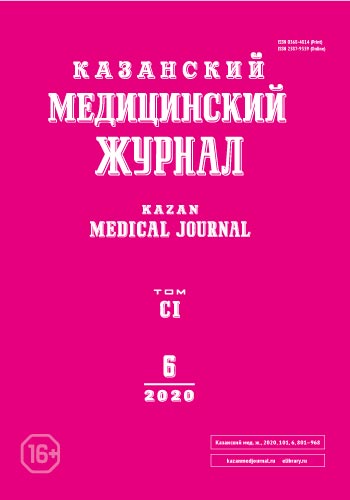Оценка риска возможного возникновения вспышек сибирской язвы в Республике Татарстан
- Авторы: Макаев Х.Н.1, Иванова С.В.1, Мельникова Л.А.1, Муртазина Г.Х.2, Гараев А.Р.3, Родионов А.П.1
-
Учреждения:
- Федеральный центр токсикологической, радиационной и биологической безопасности
- Казанский государственный медицинский университет
- Республиканская ветеринарная лаборатория
- Выпуск: Том 101, № 6 (2020)
- Страницы: 883-889
- Раздел: Социальная гигиена и организация здравоохранения
- Статья получена: 05.11.2020
- Статья одобрена: 23.11.2020
- Статья опубликована: 14.12.2020
- URL: https://kazanmedjournal.ru/kazanmedj/article/view/48965
- DOI: https://doi.org/10.17816/KMJ2020-883
- ID: 48965
Цитировать
Аннотация
Цель. Оценка риска возможных вспышек сибирской язвы на основе ретроспективного анализа эпизоотической ситуации по данной инфекции и кадастровых данных о количестве стационарно неблагополучных по сибирской язве пунктов в Российской Федерации на примере Республики Татарстан.
Методы. Ретроспективный анализ данных заболевания животных сибирской язвой в Республике Татарстан и кадастра стационарно неблагополучных по данной инфекции пунктов в Российской Федерации провели, используя документы ветеринарной отчётности за период с 1914 по 2018 гг. Индекс эпизоотичности неблагополучных по сибирской язве пунктов определяли по формуле ИЭ=(n×t)/(N×T), а эффективность специфической профилактики данной инфекции — согласно методической рекомендации. Анализы проведены с применением статистических методов.
Результаты. Анализ результатов проведённых исследований показал, что с 1914 по 2018 гг. на территории Республики Татарстан произошло 2037 групповых и единичных заболеваний животных сибирской язвой, зарегистрировано 1208 стационарно неблагополучных пунктов по данной инфекции. При оценке риска возможного возникновения сибирской язвы среди животных Республики Татарстан установлено, что 69,8% территории республики (каждый третий населённый пункт) стационарно неблагополучны по сибирской язве и имеют серьёзный риск возможного повторного заболевания животных данной инфекцией, поэтому всё поголовье животных 1 раз в год вакцинируют против сибирской язвы. Исследованием более 11 000 проб сыворотки крови животных, вакцинированных против сибирской язвы по данной схеме, выявлено, что у 20% животных через 6 мес, а у 60% через 12 мес после вакцинации титр противосибиреязвенных антител снижается 1:2 и 1:4 ниже уровня, защищающего животное от заражения возбудителем данной инфекции. Это создаёт серьёзный риск заболевания сибирской язвой животных и людей в неблагополучных пунктах, так как возбудитель сибирской язвы передаётся от заражённого животного к человеку при ошибочном вскрытии павших животных или обработке туш скрытных носителей возбудителя сибирской язвы. Учитывая это, в регионах, имеющих серьёзный риск возможного возникновения сибирской язвы, подтверждена необходимость ввести в схему профилактики данной инфекции у животных две вакцинации в год и отслеживать их поствакцинальный иммунологический статус, что позволит поддерживать у них напряжённый иммунитет в течение всего года и своевременно ликвидировать очаг инфекции.
Вывод. Установлено, что 69,8% территории Республики Татарстан стационарно неблагополучно по сибирской язве и имеет серьёзный риск возможных вспышек заболевания сибирской язвой животных; показана необходимость проведения комплексных противосибиреязвенных мероприятий, включая двухразовую вакцинацию животных в течение года, для снижения риска инфицирования животных и населения возбудителем данной инфекции.
Полный текст
Об авторах
Харис Нуртдинович Макаев
Федеральный центр токсикологической, радиационной и биологической безопасности
Автор, ответственный за переписку.
Email: kharis.makaev@mail.ru
Россия, г. Казань, Россия
Светлана Викторовна Иванова
Федеральный центр токсикологической, радиационной и биологической безопасности
Email: kharis.makaev@mail.ru
Россия, г. Казань, Россия
Лилия Арсентьевна Мельникова
Федеральный центр токсикологической, радиационной и биологической безопасности
Email: kharis.makaev@mail.ru
Россия, г. Казань, Россия
Гульнара Харисовна Муртазина
Казанский государственный медицинский университет
Email: kharis.makaev@mail.ru
Россия, г. Казань, Россия
Айрат Рашитович Гараев
Республиканская ветеринарная лаборатория
Email: kharis.makaev@mail.ru
Россия, г. Казань, Россия
Александр Павлович Родионов
Федеральный центр токсикологической, радиационной и биологической безопасности
Email: kharis.makaev@mail.ru
Россия, г. Казань, Россия
Список литературы
- Дугаржапова 3.Ф., Чеснокова М.В., Косилко С.А., Балаханов С.В. Текущая ситуация по сибирской язве в некоторых субъектах Сибири и Дальнего Востока. Материалы ХI съезда научно-практического общества эпидемиологов, микробиологов и паразитологов. M. 2017; 203.
- Дягилев Г.Т., Чернявский В.Ф., Игнатьева М.Е. и др. Эпизоотолого-эпидемиологический мониторинг сибирской язвы в центральной и южной зонах Якутии. Якутский мед. ж. 2018; (2): 96–100. doi: 10.25789/YMJ.2018.62.29.
- Галиуллин А.К., Садыков Н.С., Госманов Р.Г. Сибирская язва сельскохозяйственных животных. СПб.: Лань. 2019; 224 с.
- Онищенко Г.Г., Васильев Н.Т., Литусов Н.В. и др. Сибирская язва: актуальные аспекты микробиологии, эпидемиологии, клиники, диагностики, лечения и профилактики. М.: ВУН МЦ МЗ РФ. 1999; 448 с.
- Симонова Е.Г., Раичич С.Р., Картавая С.А. и др. Проявления активности стационарно неблагополучных по сибирской язве пунктов Российской Федерации в современных условиях. Пробл. особо опасных инфекций. 2018; (2): 90–94. doi: 10.21055/0370-1069-2018-2-90-94.
- Еременко Е.И., Рязанова А.Г., Буравцева Н.П. Современная ситуация по сибирской язве в России и мире. Основные тенденции и особенности. Пробл. особо опасных инфекций. 2017; (1): 65–71. doi: 10.21055/0370-1069-2017-1-65-71.
- Макаев X.H., Иванова С.В. Мельникова Л.А., Чернов А.Н. Эпизоотологический анализ ситуации по сибирской язве в Республике Татарстан. Труды Федерального центра охраны здоровья животных. 2018; 16: 54–63.
- Куличенко A.H., Буравцева Н.П., Рязанова А.Г., Еременко Е.И. Сибирская язва на Северном Кавказе. Майкоп: Качество. 2016; 198 с.
- Черкасский Б.Л. Кадастр стационарно неблагополучных по сибирской язве пунктов в Российской Федерации. М.: ИнтерСЭН. 2005; 829 с.
- Ivanova S.V., Melnikova L.A., Rodionov A.P. et al. Analysis of the epizootic situation and improvement of the scheme for the specific prevention of anthrax. Intern. J. Res. Pharmaceutical Sci. 2020; 11 (1): 949–952.
- Sean Shadomy, Ahmed El Idrissi, Eran Raizman et al. Anthrax outbreaks: a warning for improved prevention, control and heightened awareness. Food and agriculture organization of the United Nations. 2016. http://www.fao.org/3/a-i6124e.pdf (access date: 15.04.2020).
- Декларация о соответствии «Набора для определения антител в сыворотке крови животных, вакцинированных против сибирской язвы, в реакции непрямой гемагглютинации». №РОСС RU.CC07.Д00022 от 07.06.2017.
- Иванова С.В., Хисамутдинов А.Г., Макаев Х.Н. и др. Методические рекомендации по оценке эффективности иммунопрофилактики сибирской язвы у крупного рогатого скота реакцией непрямой гемагглютинации. Казань: Альянс. 2019; 17 с.
- Иванов А.В., Макаев Х.Н., Мельникова Л.А. и др. Способ получения эритроцитарного сибиреязвенного антигена, способ получения контрольной положительной сыворотки для набора определения антител в сыворотке крови животных, вакцинированных против сибирской язвы, в реакции непрямой гемагглютинации и набор для определения антител. Патент №2599035С1 РФ, C12N 1/20, G01N 33/531. Бюлл. №28 от 10.10.2016.
Дополнительные файлы









